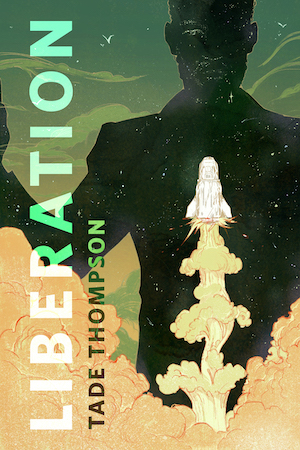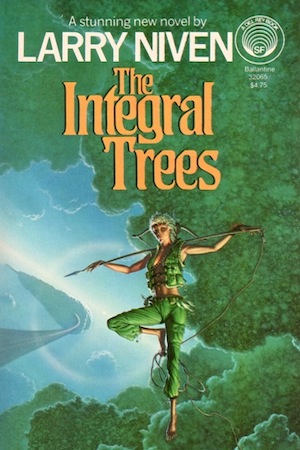In this bi-weekly series reviewing classic science fiction and fantasy books, Alan Brown looks at the front lines and frontiers of the field; books about soldiers and spacers, scientists and engineers, explorers and adventurers. Stories full of what Shakespeare used to refer to as “alarums and excursions”: battles, chases, clashes, and the stuff of excitement.
Today we’re going to take a look at one of the single most interesting books I’ve ever read, The Integral Trees, set in a peculiar solar system whose most habitable area is a torus around a neutron star, where people live among floating trees and jungles, surrounded by all manner of strange creatures. To make matters even more intriguing, the spaceship on which the original colonists arrived is still lurking in the system, with ideas of bringing this world back under control of the totalitarian State.
By the 1980s, Larry Niven was well along in a productive and popular career as a science fiction author, and could have easily been resting on his laurels and writing sequels to earlier works. But while sequels were part of his output in those years, he was also looking for new ideas—one of the most audacious of those ideas was the Smoke Ring, which became the setting for two novels. The first was The Integral Trees, serialized in Analog magazine in 1983 and published by Del Rey in 1984. My copy came to me via my then-new membership in the Science Fiction Book Club, and featured a beautiful and evocative cover by Michael Whelan, featuring a lean and elfin woman with prehensile toes, hovering in mid-air. The sequel, The Smoke Ring, was published in 1987.
About the Author
Larry Niven (born 1938) is a prolific and prominent American science fiction author. I have reviewed his work in this column before, looking at the seminal book Ringworld, the books A Mote in God’s Eye and The Gripping Hand, which he wrote in collaboration with Jerry Pournelle, and his short story collection, Neutron Star. Those reviews contain biographical information about Niven, with the review of Ringworld containing not only a more extensive biography, but also a description of the Known Space universe in which many of his stories are based.
The Smoke Ring and Other Strange Environments
Science fiction thrives on stories set in strange and exotic environments. Between these environments and the futuristic technology, characters can sometimes be overshadowed. But that isn’t a problem when the setting is fascinating in its own right. Our robotic probes have shown that all sorts of interesting environments exist within our own solar system—worlds with different gravity, different temperatures, and different chemical compositions—places that would present unique challenges to explorers. And in the realm of science fiction, even more exotic settings can be imagined. In the early days, some of those settings were downright preposterous. There were tiny asteroids with breathable atmospheres, comets that brushed the Earth and broke off chunks of the planet, and Earth-like environments in even the furthest reaches of the solar system. But as science fiction became more scientific and our knowledge of other worlds increased, those environments grew more realistic.
Science fiction authors tend to enjoy challenging the ordinary and coming up with ever stranger new worlds. They have created giant technological environments like Niven’s own Ringworld and Arthur C. Clarke’s Rama. And even keeping within the bounds of scientific possibility, they have created some exceedingly peculiar natural environments. One of the first of these I encountered was the high-gravity planet Mesklin from Hal Clement’s Mission of Gravity; over the years Clement created many a strange world. Larry Niven has followed in Clement’s footsteps and become a master of strange environments himself. If you’d like to dig into this topic a bit further, you can find an engaging article on the other worlds of science fiction here in the online Encyclopedia of Science Fiction.
The Smoke Ring, the setting of The Integral Trees, is perhaps Niven’s greatest achievement in worldbuilding. It is set among his stories of the State, a totalitarian government dedicated to spreading humanity throughout the stars with slower-than-light ramships that scoop hydrogen out of the void and use it as fuel. They use human beings as tools, copying their personalities, then using them to guide their ships, as well as freezing prisoners as “corpsicles,” utilizing them as involuntary explorers.
The strange world of the Smoke Ring was discovered by Discipline, a ramship piloted by Sharls Davis Kendy, a human personality transferred to a computer, who serves not only as ship’s commander, but also as the political officer and representative of the State. It was crewed by rebels that the State hoped to rehabilitate. They found a star orbited by a unique system. That system is centered on a neutron star, Voy, orbited by a former gas-giant planet, Gold, whose atmosphere has been stripped away by the gravity of Voy, and trails in the orbit in the form of a giant gas torus. In the center of that torus, there is a ribbon of breathable atmosphere, rich in life. The ramship is equipped with organisms that can be seeded to terraform unsuitable environments, but they find the flora and fauna here surprisingly compatible with life from Earth. While the Smoke Ring is full of free-floating forests and ponds that exist as spherical globes, the humans are attracted to large trees that look like mathematical integral symbols, whose midpoints center in the torus, but which are long enough that their outer and inner tufts have tidal forces which simulate the gravity humans find comfortable. The native animals are strange—most of them are able to fly, and most exhibiting trilateral symmetry that allows them to see in all directions at once.
Kendy’s plans to plant a colony for the State are dashed, however, when the still-rebellious crew flee in the eight Cargo and Repair Modules, or CARMs, that allow operations beyond the ship. In the centuries since the crew escaped and struggled to establish colonies throughout the Smoke Ring, Kendy and Discipline have lurked behind Gold, patiently plotting a way to reestablish the power of the State.
The Integral Trees
The Quinn tribe is in trouble. They live in the tuft at the end of a gigantic integral tree, where tidal forces provide a comfortable low-gravity environment. But the tree they live on passed close to the planet Gold, and since then the tree and its ecology has been deteriorating. They don’t realize it, but their tree has been slowly falling out of the Smoke Ring toward Voy. The Chairman of the slowly starving tribe has decided to send a team of hunters and explorers up the trunk. He has picked people he feels are expendable, like the hunter Clave, who angered him by leaving the Chairman’s daughter for the two young sisters Jayan and Jinny. There is the young and inexperienced Gavving, who has just survived a battle with a swordbird that killed one of his hunting companions. There is the legless woman Merril, and Jiovan, who lost one of his legs in a hunting accident, as well as sour old Alfin, who suffers from a fear of heights. But the tribe Scientist does not feel this mission is a forlorn hope, because he has sent his assistant, the Grad Jeffer, along with a precious computer and data cassettes.
The team makes their way up the trunk, aided by the fact that the tides decrease as they climb to the center of the tree. They find new flora and fauna, but as they reach the center, they’re attacked by warriors from the Dalton-Quinn tribe which inhabits the far tuft of their tree, warriors who are celibate women pledged to service. During the battle, the tree fractures apart, and the survivors of the battle float away, clinging to a large piece of bark. It turns out integral trees have a means of surviving falling from orbit, sacrificing the inward part of the tree to gravity to save the rest. This means that the former Quinn tribe is doomed, and the members of the expedition must now become the tribe, with Clave as Chairman and Jeffer as Scientist. It becomes apparent that the previous Scientist expected something like this, which is why he let Jeffer take his computer. Gavving acquits himself well in the battle, killing two of the enemy. The only survivor from the other tribe is Minya, who was not happy with her celibate life and, seeing it as an avenue toward acceptance, proposes marriage to Gavving.
The survivors harpoon a giant moby, or air whale, and it tows them toward a cloud where they hope to find some water. Inside the cloud is a zero-gravity jungle, inhabited by the Carther states, a tribe even taller and leaner than the Quinns. Before they even have a chance to adapt to this new situation, the jungle is attacked by warriors from London Tree, a very large tribe who have a functioning CARM. The Quinn tribe is separated, with some staying with the Carther group and the rest becoming “copsiks,” or slaves on London Tree. As the slaves are adapting to their new and unpleasant life, it turns out the jungle also has a means of propulsion, and soon the tables are turned on London Tree, as the Carther warriors swarm aboard their tree, and with help from the Quinns, take control of their precious CARM. As the tiny Quinn Tribe struggles to learn how to control the CARM, they encounter the malevolent Kendy, and their lives hang in the balance right up until the end of the story.
Final Thoughts
The Integral Trees is an exciting book whose setting is the best part of the tale. The idea of living in an environment where there is no ground is genuinely fascinating. And if the characters are overshadowed by the environment, in this case it is not because they are poorly imagined, but simply because the setting is so creative and compelling.
And now it’s your turn to talk: If you’ve you read The Integral Trees, I’d enjoy hearing your thoughts. And I’m also interested in hearing what other books that you have read with fascinating science fictional settings.











Two books with very unusual settings that impressed me a lot were Stephen Baxter’s Xeelee books “Raft” and “Flux”, and in both cases, humans had to adapt (or were adapted) to those environments. “Raft” plays in a universe with substantial higher gravity, also in an area where breathable air is available in space if I remember correctly, on objects like the remains of their old starship etc. as planets can not exist under the conditions of that universe. “Flux” on the other hand has microscopically small humans living inside a neutron star, also with its special environmental conditions that play an important role in the novel.
Stephen Baxter is definitely an author who followed in Niven’s footsteps, giving us all manner of strange enviroments in his stories.
I remember reading this in Analog. IIRC, I felt it was a great setting, with an ok plot, and boring characters. Don’t recall ever getting around to reading the paperback.
“Dragon’s Egg” by Forward was a “read once” with a great setting (life on a neutron star!), decent plot driven mostly by the setting, and characters that were fairly thin.
I just started rereading The Integral Trees, and wouldn’t you know it, Niven dedicates it to Robert L. Forward, who helped him work out the parameters of the Smoke Ring. I guess that doesn’t surprise me.
I seem to recall the sequel, “Starquake”, had a better plot. A sort of apocalyptic disaster novel.
Rereading the book was fun, because while I remembered the setting vividly, I had forgotten most everything else about the book. It felt like I was reading it for the first time again. So I guess sometimes boring characters can be an advantage.
That’s pretty much true of Robert L. Forward’s books in general — amazing physics ideas, weak writing and characterization. I’ve often wished he’d collaborated with a better writer. (His son Bob Forward was a good TV-animation writer in the ’80s-’90s, but apparently they preferred not to collaborate.)
The Integral Trees and The Smoke Ring are longtime favorites of mine, though I sometimes forget which one comes first, since it sounds to me like The Smoke Ring should come first (though I guess it makes sense because the first book is more about the trees and the second explores the wider setting more). I actually liked them better than the Known Space series.
It didn’t occur to me until now, but the depiction of a culture living in the tuft of a giant tree and learning more about their world as they climb its length must have been an inspiration for the Biauru, the alien species in my novelette “Aleyara’s Descent,” which I wrote in 1998 although it wasn’t published until the May/June 2023 Analog (long story). The Biauru live in a rainforest canopy so thick that it’s effectively a solid surface, and the novelette is about its title character leading an expedition down one of the redwood-sized trunks to prove that the dark emptiness beneath the canopy isn’t the bottomless realm of the dead.
I also learned a lot about orbital mechanics from these novels, and for years I tried to think up my own variation on the Smoke Ring concept on a larger scale, positing something where a Jovian planet shed a hydrogen ring that its upper-atmosphere inhabitants had migrated out into. But I couldn’t get the physics to make sense, and I eventually realized the Jovian’s gravity would clear out the gas in its orbit rather than concentrating it into a ring. I eventually reworked it into a setting in my 2010 Analog story “The Hub of the Matter,” an uninhabited but spectacular system where Jovians orbiting inside the expanded atmosphere of a red giant have concentrated it into several rings between them, like the shepherd moons of Saturn’s rings.
I remember that giant forest story. You might also have been inspired by the forest Carson Napier parachuted into in Burrough’s Pirates of Venus.
Glad you remember the story (which is the title story in my upcoming collection that will be hopefully be out this month). But no, I never read Pirates of Venus. The only Burroughs I’ve read are the first few Tarzans and one or two John Carters.
In rereading The Integral Trees, I’m discovering more things that must have unconsciously (or consciously?) influenced my worldbuilding for the Biauru in “Aleyara’s Descent,” like the inhabitants of a giant tree weaving their homes from its living branches, or the trunk having fan-shaped fungi growing from it (although mine were much larger, and we were probably both influenced by real shelf fungi).
Incidentally, I was aware of the book for some time before I read it, and I misinterpreted the title, thinking it was stressed on the “Trees” part, as in trees that are integral to something, or to each other. Once I read the book, I realized it should be stressed on the “Integral,” in that “integral tree” is the name of the species, like redwood trees or maple trees.
I reread those a couple years ago. Niven has a hell of an imagination, but he tends to just sketch in the actual characters. (and is also a bit of a toxic misogynist). I will give a shout out for the brief queer representation, though. (Blink and you’ll miss it, but Sal, one of Mina’s Triune Squad comrades, is AMAB). The setting has a lot of potential that isn’t fully explored. I stole bits of it for a game I ran once, the players had a lot of fun.
I don’t know if you’re talking about Niven in real life, but I just finished the book and I didn’t see anything misogynistic about its storytelling. The female leads are forced into sexual slavery by the bad-guy culture, and this is treated relatively more casually than it probably would have been from a female author, but it’s clearly portrayed as a bad thing, the traumatic impact on the women is acknowledged, and they do get agency and take an active role in their escape. Beyond that, the female characters do tend to be viewed through a male gaze and placed in sexual roles, but no more than was typical of the era, and many of them are strong, capable fighters. In proportion to 1980s popular fiction in general — which could be incredibly misogynistic at times — I’d actually call this one relatively progressive.
IIRC, that is not quite true. Kendy had secret orders to plant a colony if he encountered a habitable world, and drove his crew out of the ship to force them to settle the Smoke Ring without ever telling them why. After all, the orders were secret.
Yes – as I recall, Kendy assesses the gas torus as perfect for colonisation due to its huge habitable volume (much bigger than a planet) and the fact that it is immune to comet/asteroid strikes so makes a suitable longterm home to ensure the survival of humanity
Thanks for that info, somehow I missed that. I’m getting the urge to reread The Smoke Ring to find out more.
TBH, Kendy is the only character I can remember.
Long one of my favorites.